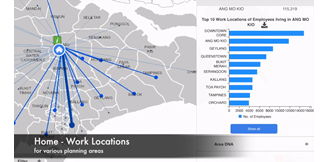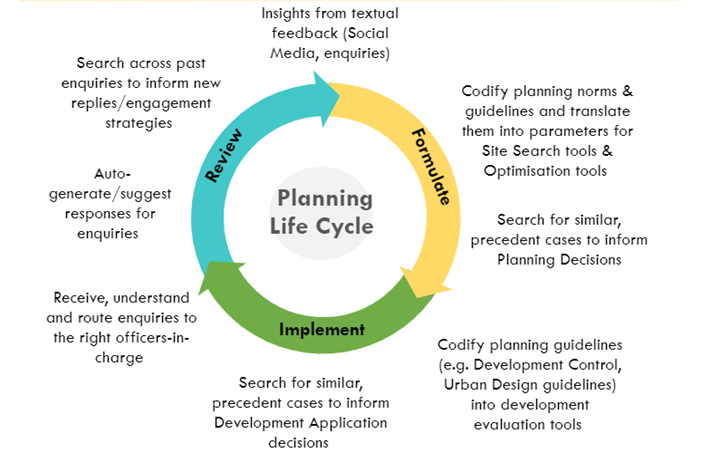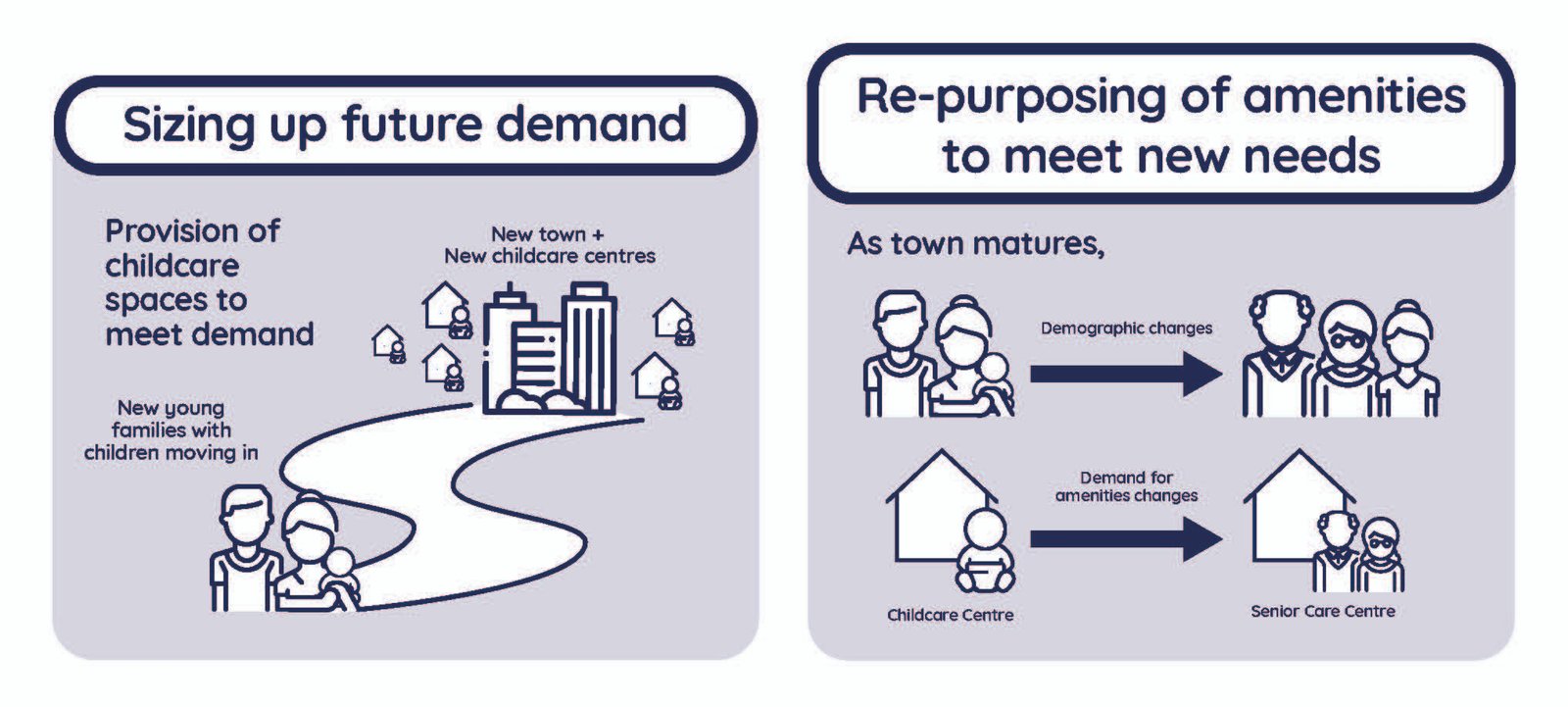In today’s rapidly-changing and increasingly uncertain climate, planning for the future has become more important than ever. URA’s planners will have to be more data-informed in the way we plan, to respond quickly to changes and identify optimal land and infrastructure options, so as to meet the needs of our communities and businesses of today and tomorrow.
Hear from Huang Zhongwen, Director, Design & Planning Lab (DPLab) at URA on how advancements in Artificial Intelligence (AI) capabilities can be harnessed to support the development of robust plans that will safeguard Singapore for current and future generations.
Singapore and Urban Planning
Urban planning is not new to Singapore. Since the 1960s, Singapore’s urban planning processes have been comprehensive and systematic, in order to ensure a high-quality living environment for all.
We were one of the world’s first movers in using planning technology. And in our pursuit to meet the evolving needs of our citizens, we have sustained the relevance of our planning processes by keeping up-to-date with technological advancements and fusing our local innovations with global expertise.
Integration of computing technology for urban planning in Singapore began in the 1980-90s with the adoption of computerisation and Geospatial Information Systems (GIS). In the 2010s, we embarked on digitalisation to tap on the recent availability of digital data, data science tools, and advanced GIS capabilities such as 3D simulation and viewshed analysis. These have laid a strong foundation for us to further push the frontier of our digital toolkits with meaningful AI solutions.


Left: URA’s ePlanner is a multi-platform geospatial urban planning analytics system that consolidates land-use planning information; Right: URA has developed an inventory of 3D models with different levels of detail for diverse urban design needs
Here are three ways that AI solutions can strengthen how we plan for Singapore and its people.
1. AI solutions will expand and strengthen our planners’ toolkits
People might not know this, but AI solutions are all around us in our daily lives – in our use of search engines, social media, e-Commerce sites, and more. For instance, how internet searches return relevant results or how Google Map recommends the best route options are based on equations and algorithms. AI works silently in the background to make searching and retrieving information more convenient and efficient.
Ten years on from Marc Andreessen’s claim that “Software is eating the world”, AI technologies have since assimilated into almost every aspect of the working world. For instance, they are used by professional gamers to hone their skills and to develop new tactics. Quite similarly, at URA, we see potential for AI capabilities in areas such as information retrieval to enhance the way urban planners work.
We are using AI to develop a knowledge base, which can then be used to model planning information and establish relationships between topics and cases. This would not only assist planners in sieving out relevant information from large volumes of data, but also allow industry stakeholders to search for planning information more efficiently.
As such technologies mature, they also present potential for further applications. In the longer term, we foresee planners using smart assistants to study a wider range of scenarios and their trajectories and to evaluate planning options.
AI solutions are also commonly found in the supply chain sector to aid in the planning of the most efficient delivery sequences and routes. In a similar vein, we are deploying Robotic Process Automation (RPA) and Natural Language Processing (NLP) across URA, to help us conduct our operations in a more resource-optimised manner. This has given rise to the automation of routine tasks, which could include for example, chatbots that can respond intelligently to public queries, and the sorting and textual analysis of large datasets such as planning decisions and public feedback data.

NLP tools can be incorporated into the formulation, implementation, and review of urban planning tasks
As effective as AI is, the ability for planners to understand stakeholders and their pain points remains integral to the work we do at URA. As such, it is important that we spend less time on labour-intensive tasks that can automated or sped-up through AI, so as to spend more time on in-depth analyses and engaging communities.
By implementing tools such as RPA and NLP at URA, this enables planners to allocate time and effort for more meaningful work.
2. AI-enabled urban planning enhances responsiveness to changing needs
AI solutions are also widely used in trend monitoring and anomaly detection. One example lies in the use of algorithms to detect patterns in large time-series data. These are used often by those working in the engineering and finance sectors.
At URA, these aid urban planners in identifying and anticipating changes in activity patterns and user behaviour.

Planners must assess how amenities can be repurposed to address future needs
Using AI-enabled spatial and data analytics helps us to develop rich insights into utilisation patterns of public spaces and amenities. This is especially important in land-scarce Singapore, where data-informed planning is needed to judiciously optimise our limited land.
Optimisation models can be employed to assess siting, sizing, and timing options for adding or re-developing facilities and infrastructure. For example, we are already piloting the use of AI models to analyse and estimate future town demography, project demand for future social community services, and assess options to optimise the placement and service catchment of facilities. This will continue to go a long way in enabling us to meet the needs of an ageing population in a more targeted and effective way.

Developed in-house, OneTool enables planners to map, model and more accurately project future demand for facilities at the block, ward and town level
AI tools thus support URA’s work in optimising land use, improving citizens’ accessibility to services and amenities, and managing utilisation of infrastructure. In the long term, this helps us to plan in a more anticipatory and agile manner to meet ever-evolving needs.
3. Building a stronger planning community and innovative ecosystem
Investing in people and shared planning capabilities puts us in good stead to build a more resilient and future-ready Singapore today, and for the decades to come.
We hope to build a new generation of planners and industry professionals who will leverage AI to foster an innovative and data-enabled planning ecosystem.
In continuing to facilitate knowledge-exchange with industry, this will allow professionals such as architects, engineers and developers to tap into AI solutions to assess the performance of design options more easily and identify ways to improve their designs.

A virtual panel discussion on AI-powered city planning at the Plan.AI speaker series organised by DPLab and SGInnovate in May 2020.
We also look forward to having AI and technology enthusiasts, as well as academia and industry partners, join us in our journey to make Singapore a better place to live, work, and play in. We are excited by the possibilities, and trust that together we can create the art and science of urban planning in the age of AI.
We are looking for talented data and AI scientists to join our team. If you are passionate about using your skills to build a sustainable and future-ready Singapore, join us.
Source: https://www.ura.gov.sg/Corporate/Resources/Ideas-and-Trends/AI-in-Urban-Planning



